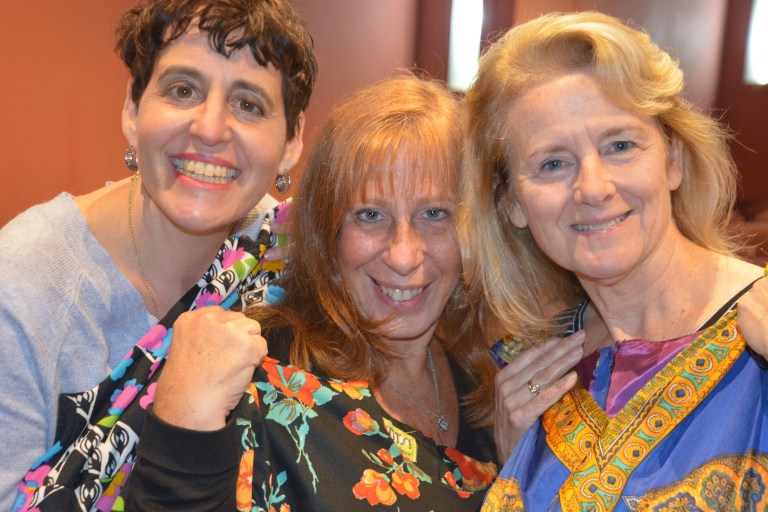
Why do certain songs catch on and become smash hits? Why do only a few musicals having long runs? An obvious answer is that amazing talent has been enlisted during production. To establish a Broadway hit you must have great songwriters, great directors, amazing singers and actors, talented choreographers and experts in set design and lighting and costumes.
All that’s true but to have a smash Broadway hit you need something else. You need to tap into the culture’s deepest hopes. It has been said that the arts are the way that a culture dreams.
The culture’s dreams remain unconscious until an artist somehow expresses them for us. If the playmaker and songwriter taps into our deepest hopes they just may produce a smash Broadway hit.
So when I got a call from producer Margo Bayroff of the Herricks Community Players I was more than happy to meet with her and explore what this seasons offering was all about. We met at the Herricks Community Center Theatre where Margo told me that they had decided to put on a musical revue based upon the biggest Broadway shows of the 1970’ and 1980’s including classics taken from “Chicago” (1975), “Sweeney Todd” (1979), “Shenandoah” (1975), “Phantom of the Opera” (1988),” Annie: (1977), “Grease” (1971) and “Little Shop of Horrors” (1986.)
I wondered why they chose to review the ’70s and ’80s and she told me “those were much simpler times back then where the country still had hope and a brightness to it. The fashion colors were gay and bold with lots of oranges and pinks and bright blues. In the ’70s we still had some flower children around, the American dream was still alive and we felt maybe we could bring back some of that brightness.”
I thought that was well put. And soon enough we were joined the co-producer Lisa Simon-Weitz and costume designer/ actress Maura Calio along with director Susan Weber via the phone.
They have a cast and crew of 45 including musicians and child actors and as I was shown around the backstage I began to realize just how much time and effort is put into a production like this even though it will only run for three days.
After our chat I returned to my office where I planned on investigating the songs they chose and what these songs would say about the 1970’s and the 1980’s.
The first song I researched was Mr. Cellophane from the play Chicago.
This will be the revues second number and was memorably performed on Broadway by Joel Grey and by John C. Reilly in the film version. The song is about schlubby pushover Amos Hart who expresses what it feels like to be invisible and ignored by the woman he loves. In the film version, it was done like a fantasy piece with John C. Reilly dressed like a tramp clown reminiscent of Charlie Chaplin or Emmett Kelly. It is worth noting that Reilly came up with his own choreography for the piece.
As a psychoanalyst, we are trained to analyze the cultural zeitgeist. The 1970s was the birth of the feminist movement and I thought this song was a true symbol of the embattled and weakened and even castrated male of the 1970s who seemed rather confused as to what to do about female power. And the Me Too movement of today attests to the fact that this issue has not been adequately resolved in any way.
The second song from the show I chose to analyze was “Somewhere That’s Green” from the comedy horror musical “Little Shop of Horrors” (1986.) In thisheart-rendingg number Audrey sings of her sweet desire to have a simple home with a white picket fence and a nice green lawn which “doesn’t have to be as fancy as those Levittown homes.” Not only is this song about the slow and inevitable death of the American Dream but the play itself symbolizes what is to emerge as America’s greatest enemy. You will recall that this play was about a man-eating Venus flytrap who could only grow and prosper when fed by human flesh and blood. And it that’s not a perfect symbol of American corporate greed I don’t know what is.
As I posited at the beginning of this piece smash hits only happen when they tap into the culture’s deepest fears and dreams. The fact that the Herricks Community Players have chosen the do a revue of the shows of the 70’s and 80’s means that they had the good sense to explore the zeitgeist of those times. What I discovered was that the birth of feminism in the ’70s and the death of the American Dream in the ’80s were two great big issues that artists and theatre-goers alike were worried about. Both those issues are still with us today. Broadway is an amazing form of entertainment and one of America’s greatest achievements. People come to New York from all over the world to go to a Broadway show.
Along with being entertained there is also something happening to the audience member unconsciously as well. They are connecting to the American soul.
Go see Herricks to Broadway on Friday through Sunday, Oct. 26, 27 and 28 at Herricks Community Center Theatre at 999 Herricks Road in New Hyde Park. Tickets are $25.
Let’s face it that’s a whole lot cheaper than paying for 45 minutes on the analyst’s couch. And a lot more fun too.






